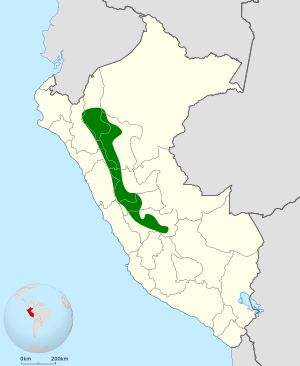Rufous-vented tapaculo facts for kids
Quick facts for kids Rufous-vented tapaculo |
|
|---|---|
| Conservation status | |
| Scientific classification | |
| Genus: |
Scytalopus
|
| Species: |
femoralis
|
 |
|
The rufous-vented tapaculo (Scytalopus femoralis) is a small, shy bird that lives in the mountains of Peru. It's known for its unique song and its reddish-brown bottom (vent area). This bird is part of a family called Rhinocryptidae, which are often called tapaculos. They usually hide in thick bushes and are hard to spot.
Contents
About This Bird's Family
The rufous-vented tapaculo is a special type of bird. It belongs to a group of birds called tapaculos. Scientists have studied this bird carefully. They found that some birds that used to be thought of as the same kind of tapaculo are actually different species. For example, the Santa Marta tapaculo and the long-tailed tapaculo are now considered separate birds. This helps scientists understand how different bird species are related.
What Does It Look Like?
The rufous-vented tapaculo is about 12.5 centimeters (5 inches) long. That's about the length of a pen. Male birds weigh between 21 and 28 grams. Female birds are a little lighter, weighing 20 to 24 grams.
Adult birds have a dark brown head and back. Their rump, which is their lower back, is a dark reddish-brown color. The throat, chest, and belly are a lighter gray. The sides of their body and the area around their tail are cinnamon-colored. These parts also have dark stripes. Young birds are brown on top with faint stripes. Their underside is yellowish-buff with dark stripes.
Where Does It Live?
The rufous-vented tapaculo lives in the central Andes mountains of Peru. You can find it from the southern part of the Amazonas region down to the Junín region.
This bird likes to live in the thick undergrowth of humid forests. It lives in both old, untouched forests and forests that have grown back after being cut down. It usually lives at elevations between 1,000 and 2,050 meters (about 3,300 to 6,700 feet) above sea level. Sometimes, it can be found even higher, up to 2,550 meters (about 8,400 feet).
How Does It Behave?
Scientists are still learning about the rufous-vented tapaculo. We don't have much information about what it eats or how it raises its young. However, we do know about its song! The bird sings a single note that goes down in pitch. It repeats this note for several minutes. You can listen to its song online here.
Is It Safe?
The IUCN (International Union for Conservation of Nature) checks on how safe different animal species are. They have said that the rufous-vented tapaculo is of "Least Concern." This means it's not currently in danger of disappearing.
This bird lives in a very large area. Even though we don't know the exact number of these birds, scientists believe there are many of them. Their population seems to be stable, which is good news for this unique Peruvian bird.
See also
 In Spanish: Churrín ventrirrufo para niños
In Spanish: Churrín ventrirrufo para niños


